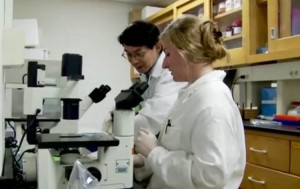Understanding chemical exposure from the inside, out

Dr. Jun Nakamura (above, left) and other researchers with Project 1 are working to characterize the endogenous exposome to better understand which exposures are most likely to cause DNA damage that can lead to cancer.
We worry about our exposure to cancer-causing chemicals in our environment, our diets, our homes and workplaces. But some of those very same chemicals are actually produced inside our bodies as byproducts of normal metabolism, inflammation, infections and other metabolic processes. The challenge is to be able to differentiate whether chemical levels inside a person’s body come from external (exogenous) or internal (endogenous) sources, as well as which exposures are most likely to cause DNA damage that can lead to cancer.
For more than two decades, investigators at the UNC Superfund Research Program (SRP) have led efforts to illuminate what scientists now call the “exposome” – the totality of one’s lifetime exposures to chemicals, from birth through old age, and how that might affect health and susceptibility to disease. In particular, our SRP has focused on the endogenous exposome – the chemicals produced by our cells.
“People might think that it’s only exposure to chemicals out in the environment that are causing problems, but there are lots of chemicals inside our bodies that damage our DNA,” says Dr. James Swenberg, director of the UNC SRP and the principal investigator for most of this work. “We need to understand when and how the endogenous exposome is responsible for inducing genetic changes that are heritable and that cause disease.”
Since 1992, UNC researchers have been looking at DNA damage from toxic chemicals like vinyl chloride and PCBs found at Superfund sites and elsewhere. By the early 2000s, UNC investigators had discovered biomarkers that enabled them to determine how much ofthe DNA damage found in cells was endogenous and how much came from external exposures. Since then, Swenberg and team have compiled critical data on a variety of toxic chemicals, including formaldehyde and acetaldehyde – even discovering, for instance, that is the endogenous levels in patients with a genetic defect called Fanconi anemia that causes bone marrow failure and leukemia.
In April 2014, Swenberg and colleagues published a comprehensive review of the SRP’s scientific findings in the journal DNA Repair. These findings are informing national policy and risk assessment protocols.
“Now that we know there will always be a baseline level of these chemicals in our bodies from endogenous sources, we can set science-based regulatory policies,” said Swenberg, who recently shared UNC data with the EPA to help develop guidelines to assess risk from exposure to formaldehyde. “We’re working at the intersection of environmental health, regulation and clinical research, which presents exciting opportunities from clinical and public health aspects.”
——————————————–

